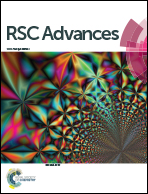Catalytic activity of mesoporous Ni/CNT, Ni/SBA-15 and (Cu, Ca, Mg, Mn, Co)–Ni/SBA-15 catalysts for CO2 reforming of CH4
Abstract
The CO2 reforming of CH4 to H2 over a catalyst is an effective method for renewable energy generation. In this study, SBA-15 and CNT were chosen as supports for the Ni-based catalysts prepared by the impregnation method. The FESEM images demonstrated that NiO particles were rhombic and well distributed on the SBA-15 surface. The XRD patterns showed that the chemical state of Ni changed after the reforming reaction; the main crystals on the fresh and spent Ni/SBA-15 were found to be NiO and Ni0. The catalytic performance of Ni/SBA-15 in CO2/CH4 reforming was found to be superior to that of Ni/CNT. The results of the TGA and BET analysis demonstrated that spent Ni/SBA-15 (at 600 °C) showed no catalytic decay as an insignificant amount of coke was deposited on the catalyst supports. Moreover, Ni-based bimetallic catalysts were studied for the reforming reaction, and the activity of the catalysts with respect to metals was observed to follow a particular order: Cu–Ni > Mg–Ni > Co–Ni > Ca–Ni > Mn–Ni. The Cu–Ni/SBA-15 catalyst exhibited higher catalytic activity at a reaction temperature of 650 °C as compared to the others; the H2 yield (40%) was not decreased as the reaction time increased, and the conversion of CO2 and CH4 is 77% and 75%, respectively.


 Please wait while we load your content...
Please wait while we load your content...